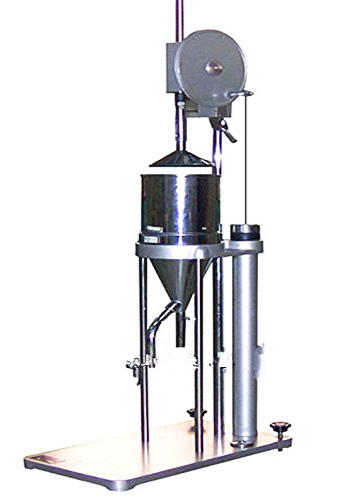The pulp freeness tester or slowness tester are extremely sensitive apparatus while applied effectively. Freeness of pulp is a measure of precisely how rapidly water can drain from a diluted fiber furnishes suspension. Drainage rate is related to the surface conditions and swelling of the fibers. On many occasions there is a correlation between freeness values and either a target level of refining of pulp or the easiness of drainage of white water through the wet web, especially in near the beginning sections of a Fourdrinier former. Standard tests of pulp freeness are based on gravity dewatering throughout a screen. The devices are designed so that an operator can judge the rate of dewatering by monitoring the volume of liquid collected in a graduated cylinder.
Freeness of pulp tends to be decreased by refining and by increase in the intensity of fines in the fiber furnish. Pulp freeness could be enhanced by use of drainage aids, elimination of fines, or enzymatic treatments to convert mucilaginous materials into glucose. The chemical pulp fibers turn into incredibly flexible by ample refining, and the fiber pad will packed in incredibly much more by the higher head in the hand sheet former than in the SR tester, and the consequent drainage time will increase correspondingly. It’s been emphasized that the standard readings of freeness or slowness keep minor similarity to the real drainage process on the paper machine wet section.
Schopper Riegler and Canadian Standard Freeness Tester are two Standard widely used pulp freeness tester. None are usually accepted for all through the paper machine. SR is dominates for chemical pulp whereas CSF is for mechanical pulp.
The Schopper Riegler (ºSR) test

Pulps schopper riegler freeness tester
The Schopper Riegler (ºSR) tester is widely used for trace the changes in the drainage speed of different chemical pulps throughout beating and refining. The refining of pulps is one of the most significant periods in the paper production process and also because it consumes considerably power and influences firmly the sheet forming and its physical properties. Variant in pH can have an effect on the chemicals controlling the pH in the process. Small amounts of electrolytes might have some substantial effect on the ºSR value.
Schopper Riegler tester has two parts; sample chamber and funnel. The upper chamber consists a sealing cone operates on a lever system and a wire screen. On the other hands the funnel consist two outlets (a bottom orifice and a side outlet), a spreader cone and a bent. Moreover a measuring glass for collect the overflow.
Two grams of pulp fibers sample is to be taken, then dilutes it up to 1000ml followed by well stirred. After that it put into the upper chamber of SR-tester. While the cone is elevated, the water drains throughout a wire screen. At the same time, the pulp fibers in the sample form a pad on the screen. The water flows into a funnel. The draining is rapid if the stock is “free” whereas it is slowly when the stock is “wet”. The design of the bottom orifice is such that a certain draining rate ought to be surpassed before there is an overflow from the side. The overflow is collected in a measuring glass. This is scaled so that 1000 ml overflow refers to 0 ºSR, and 0 ml overflow refers to 100 ºSR. Between these boundaries, the level is linear and a 10 ml increase is equivalent to 1 ºSR. working range from 10-90 ºSR. The test must also be performed at a temperature of 20 ºC. If the consistency or temperature differs, it is need to correction of obtained ºSR-value ought to be made. It is recommended that the sample should be test twice. If the test result differs by more than 4 %, the entire test should be repeated.
The freeness tester or slowness tester instruments have some serious limitations, that some people in the paper industry are not aware. The pulp freeness result usually employed far beyond what is really justified. It is necessary to understand just what the actual tools reading through studies, and also their particular issue.

Please send me the names of chemicals which we can use for increasing the drainability of water out of the pulp there at wet end.
To improve drainability you can use cationic starches
Use Nalco chemicals
Like ASA and flocculant
what is the chemicals can be used in wet
end and in size press with oxidizing starch
to improve the stiffness of paper sheet (fluting paper)
by using recycle waste paper as stock furnish.
many thanks
Use retention chemical in pressure screen outlet, drainage will get improved,u can use solenis hercobond 5327A product.
How to improve caliper in low gsm (65-70) writing & printing paper without compromising ash% , Press and calender load and moisture content?
You can see the post How to increase the caliper of the paper
When consistency less than 0.20% then how will measure the Freness .
During refining SR value increases from 18 to 34, and csf value decreases from 400-500 to 300-400, what this SR and CSF number indicate?
when consistency decrease measure the freeeness
what is the range of SR in recycled kraft paper
and send me the chart of consistency & degree sr range from 100 gsm to 150
and the procedure to test
How to increase the viscosity from 400 ml/cm till 500 in pulp and sheet
Which standard rank of freeness of pulp
This is Wonderful blog. Find it very interesting, informative and useful. Keen to know more about it in detail.
What is the mesh of the screen in this SR tester , because when the screen is damaged how to replace ?
We have smoothness issues in our greyboard production. Could improper refining be a cause of this?